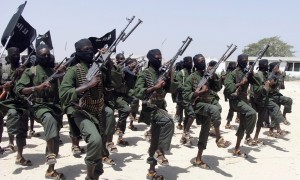
Earlier today, Shabaab launched a large-scale suicide assault on Somalia’s Criminal Investigation Department’s (CID) headquarters in Mogadishu. The attack, which is the second of its kind in Somalia’s capital in the past week, left at least six people dead and several others wounded.
According to reports, Shabaab began the operation by detonating two suicide car bombs near the perimeter of the headquarters. Following the car bombings, a small assault team was able to breach the perimeter and enter the complex. Five civilians and one police officer were killed in the assault, while the four Shabaab fighters who entered the CID headquarters were killed, according to Al Jazeera. The number of casualties released by Shabaab’s Shahada News largely matches the numbers given by Al Jazeera.
The suicide raid, or coordinated attack using one or more suicide bombers and sometimes a follow-on assault team, is a tactic frequently used by al Qaeda and its branches, as well as allied groups such as the Afghan Taliban, the Movement of the Taliban in Pakistan, Lashkar-e-Taiba, and the Islamic Movement of Uzbekistan. The Islamic State also often employs this tactic. Suicide strikes are commonly executed by jihadist groups in Iraq, Syria, Yemen, Afghanistan, Pakistan, Somalia, and Nigeria.
Today’s invasion in Mogadishu, comes just days after Shabaab mounted a similar strike near an African Union base near the Mogadishu airport. In statements released by the al Qaeda branch, it confirmed that Saleh Noh Mohamed, a former Somali Member of Parliament who joined the group in 2010, took part in one of the suicide bombings on the base. The attack left 13 people dead and 19 others wounded. [See Threat Matrix report, Shabaab claims former MP involved in Mogadishu suicide attack.]
In addition to the attack on the CID headquarters, Shabaab launched an assault on a Somali military base near Afgoye just outside of the Somali capital. The Somali military claimed to have repelled the offensive while Shabaab said it inflicted heavy casualties on the military, Shabelle reported.
Shabaab continues to demonstrate that, regardless of a large presence of African Union forces, it retains the ability to strike high-security areas. Since 2014, Shabaab has attacked the parliament, the president’s compound, and a high security intelligence headquarters, as well as numerous hotels where government officials meet. In June 2013, a Shabaab team struck at the United Nations Development Program (UNDP) compound in Mogadishu; several UNDP employees were killed and the jihadist group briefly took over the compound. And in 2010, Shabaab was able to launch a suicide assault on an African Union medical clinic in the Mogadishu airport.
Despite an African Union-led offensive that has been backed by covert US airstrikes and has cost Shabaab territory in the south over the past several years, the jihadist group remains a potent force in the country. It continues to exhibit the ability to launch complex operations in the capital, and has harassed African Union and Somali forces in both southern and central Somalia. In the past seven months, Shabaab has even retaken the towns of Marka, El Ade, and Badhadhe after African Union and Somali troops were forced with withdraw.








2 Comments
Another day, another identical attack.
Until the current somali armed forces start locking down Moog, restricting the thriving market in arms, ammunition, and explosives (and fertilizer), and showing themselves more actively, these attacks are going to get through.
Where are the drones?
Al Shabaab multiplies large-scale attacks in the Somalian capital. The mains administrations and the security services are although quite particularly targeted from now on the access to these places is particularly well hardened. Most of the attacks in an operational point of view are rather unsuccessful and cause more civil victims.The Shabaab movement more often targets these objectives to others as it has already been made in past (markets, restaurants…) Al Shabaab wants to demonstrate his capacity to operate in Mogadishu.
The capacity of Amnyaat’s teams to operate freely in Mogadishu is effective as indicates the string of murders wich had targeted public personalities, NGO members, politicians and religious leaders, but also high-ranking servicemen and policemen..These operations involve an important work of monitoring the targets. The main goal is to dissuad the elders and religious leaders to support the TFG. This also indicates a loss of influence and legitimacy of Shabaab movement.
The attack on SNA Base in the sector of Afgoye is a strategy to demonstrate that the Shabaab movement did not lose its military capacities. However the attack on the Ethiopian camp in Halgan stops the attempts to try to repeat the attack on the Kenyan camp in El Adde. Although the South of Somalia stays a stronghold where the Shabaab movement is active, no large-scale operation was led there successfully. Most of the time Al Shabaab settles back without fighting the key-towns wich the SNA or UASOM left due to lack of to pay the soldiers.